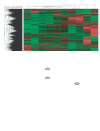Rara haploinsufficiency modestly influences the phenotype of acute promyelocytic leukemia in mice
- PMID: 21190992
- PMCID: PMC3317790
- DOI: 10.1182/blood-2010-08-300087
Rara haploinsufficiency modestly influences the phenotype of acute promyelocytic leukemia in mice
Abstract
RARA (retinoic acid receptor alpha) haploinsufficiency is an invariable consequence of t(15;17)(q22;q21) translocations in acute promyelocytic leukemia (APL). Retinoids and RARA activity have been implicated in hematopoietic self-renewal and neutrophil maturation. We and others therefore predicted that RARA haploinsufficiency would contribute to APL pathogenesis. To test this hypothesis, we crossed Rara(+/-) mice with mice expressing PML (promyelocytic leukemia)-RARA from the cathepsin G locus (mCG-PR). We found that Rara haploinsufficiency cooperated with PML-RARA, but only modestly influenced the preleukemic and leukemic phenotype. Bone marrow from mCG-PR(+/-) × Rara(+/-) mice had decreased numbers of mature myeloid cells, increased ex vivo myeloid cell proliferation, and increased competitive advantage after transplantation. Rara haploinsufficiency did not alter mCG-PR-dependent leukemic latency or penetrance, but did influence the distribution of leukemic cells; leukemia in mCG-PR(+/-) × Rara(+/-) mice presented more commonly with low to normal white blood cell counts and with myeloid infiltration of lymph nodes. APL cells from these mice were responsive to all-trans retinoic acid and had virtually no differences in expression profiling compared with tumors arising in mCG-PR(+/-) × Rara(+/+) mice. These data show that Rara haploinsufficiency (like Pml haploinsufficiency and RARA-PML) can cooperate with PML-RARA to influence the pathogenesis of APL in mice, but that PML-RARA is the t(15;17) disease-initiating mutation.
Figures





Similar articles
-
Recurrent RARB Translocations in Acute Promyelocytic Leukemia Lacking RARA Translocation.Cancer Res. 2018 Aug 15;78(16):4452-4458. doi: 10.1158/0008-5472.CAN-18-0840. Epub 2018 Jun 19. Cancer Res. 2018. PMID: 29921692
-
The DNA binding property of PML/RARA but not the integrity of PML nuclear bodies is indispensable for leukemic transformation.PLoS One. 2014 Aug 13;9(8):e104906. doi: 10.1371/journal.pone.0104906. eCollection 2014. PLoS One. 2014. PMID: 25119106 Free PMC article.
-
RARA fluorescence in situ hybridization overcomes the drawback of PML/RARA fluorescence in situ hybridization in follow-up of acute promyelocytic leukemia.Cancer Genet Cytogenet. 2002 Dec;139(2):104-8. doi: 10.1016/s0165-4608(02)00619-2. Cancer Genet Cytogenet. 2002. PMID: 12550769
-
Novel treatment of acute promyelocytic leukemia: As₂O₃, retinoic acid and retinoid pharmacology.Curr Pharm Biotechnol. 2013;14(9):849-58. doi: 10.2174/1389201015666140113095812. Curr Pharm Biotechnol. 2013. PMID: 24433507 Review.
-
A new transcriptional variant and small azurophilic granules in an acute promyelocytic leukemia case with NPM1/RARA fusion gene.Int J Hematol. 2015 Dec;102(6):713-8. doi: 10.1007/s12185-015-1857-2. Epub 2015 Sep 5. Int J Hematol. 2015. PMID: 26342691 Review.
Cited by
-
The origin and evolution of mutations in acute myeloid leukemia.Cell. 2012 Jul 20;150(2):264-78. doi: 10.1016/j.cell.2012.06.023. Cell. 2012. PMID: 22817890 Free PMC article.
-
CNVIntegrate: the first multi-ethnic database for identifying copy number variations associated with cancer.Database (Oxford). 2021 Jul 14;2021:baab044. doi: 10.1093/database/baab044. Database (Oxford). 2021. PMID: 34259866 Free PMC article.
-
Retinoic Acid Receptors in Acute Myeloid Leukemia Therapy.Cancers (Basel). 2019 Dec 1;11(12):1915. doi: 10.3390/cancers11121915. Cancers (Basel). 2019. PMID: 31805753 Free PMC article. Review.
-
Tissue factor activates the coagulation cascade in mouse models of acute promyelocytic leukemia.Blood Adv. 2023 Sep 26;7(18):5458-5469. doi: 10.1182/bloodadvances.2023010466. Blood Adv. 2023. PMID: 37450381 Free PMC article.
-
A phase I dose escalation study of oral bexarotene in combination with intravenous decitabine in patients with AML.Am J Hematol. 2014 Aug;89(8):E103-8. doi: 10.1002/ajh.23735. Epub 2014 Apr 28. Am J Hematol. 2014. PMID: 24723466 Free PMC article. Clinical Trial.
References
-
- Jurcic JG, Soignet SL, Maslak AP. Diagnosis and treatment of acute promyelocytic leukemia. Curr Oncol Rep. 2007;9(5):337–344. - PubMed
-
- Reiter A, Saussele S, Grimwade D, et al. Genomic anatomy of the specific reciprocal translocation t(15;17) in acute promyelocytic leukemia. Genes Chromosomes Cancer. 2003;36(2):175–188. - PubMed
-
- Bain DL, Heneghan AF, Connaghan-Jones KD, Miura MT. Nuclear receptor structure: implications for function. Annu Rev Physiol. 2007;69:201–220. - PubMed
-
- Oren T, Sher JA, Evans T. Hematopoiesis and retinoids: development and disease. Leuk Lymphoma. 2003;44(11):1881–1891. - PubMed
Publication types
MeSH terms
Substances
Grants and funding
LinkOut - more resources
Full Text Sources
Molecular Biology Databases
Research Materials

